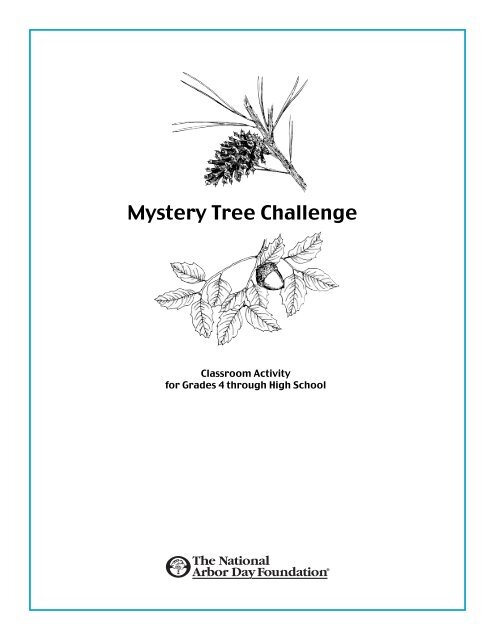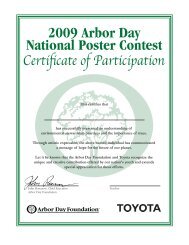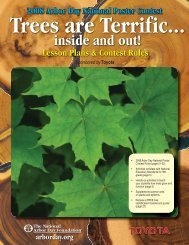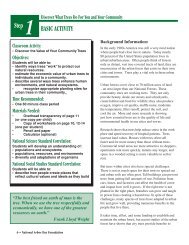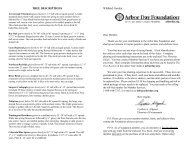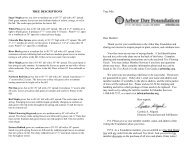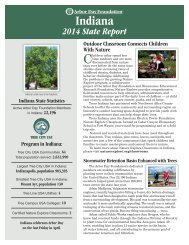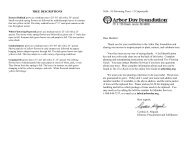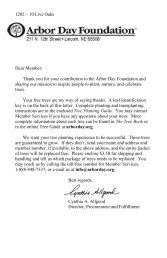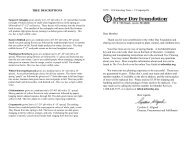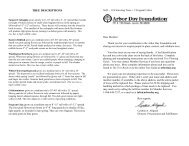Mystery Tree Challenge - Arbor Day Foundation
Mystery Tree Challenge - Arbor Day Foundation
Mystery Tree Challenge - Arbor Day Foundation
Create successful ePaper yourself
Turn your PDF publications into a flip-book with our unique Google optimized e-Paper software.
<strong>Mystery</strong> <strong>Tree</strong> <strong>Challenge</strong><br />
Classroom Activity<br />
for Grades 4 through High School
<strong>Mystery</strong> <strong>Tree</strong> <strong>Challenge</strong><br />
Engage your students in learning the basics of tree identification using this fun, hands-on activity that,<br />
with some advance planning, can work in the classroom, any time of the year.<br />
Classroom Activity Description:<br />
Students will be introduced to basic terms in tree identification then be given a mystery tree sample which they<br />
will identify by following a series of clues posted around the room. This activity introduces the concept of<br />
classification in a way that addresses all learning styles. It works well for auditory, kinesthetic, and visual<br />
learners.<br />
Grade level:<br />
This activity works well for students from 4 th grade through high school.<br />
Objectives:<br />
• Students will be able to recognize and identify several common trees in their community.<br />
Classroom Time recommended:<br />
• One 45 – 50 minute class period<br />
Materials Needed:<br />
• <strong>Tree</strong> samples (leaves and fruits/seeds) for identification<br />
• <strong>Tree</strong> clue sheets #1-#45 (printed off from this web site)<br />
• Scotch tape or tacks<br />
• <strong>Mystery</strong> <strong>Tree</strong> <strong>Challenge</strong> Worksheet and pencil (one per child)<br />
National Science Standard Correlation:<br />
• Develop an understanding of diversity of organisms and structure<br />
• Develop an understanding that structure can be used for identification<br />
• Develop an understanding that the characteristics of an organism can be learned from the combination of<br />
its traits.<br />
Advance Preparation:<br />
Collect leaf and seed samples from common trees in your community or near your school. You may wish to<br />
collect samples of tree species included in “<strong>Tree</strong> Examples” list since this activity is written using these trees as<br />
models. If trees on this list are not found in your area you can select different tree species and use the existing<br />
framework to create your own clues specific to your tree samples. The National <strong>Arbor</strong> <strong>Day</strong> <strong>Foundation</strong>’s What<br />
<strong>Tree</strong> Is That? guide can help you identify your sample trees and aid you in creating your own clues specific to<br />
your tree samples. The What <strong>Tree</strong> Is That? guide is available online at www.arborday.org/trees/treeid.html.
This activity is designed for students to work in pairs so, for a class of 24 students, 12 leaf samples would be<br />
adequate. It is not necessary to have a sample of each tree on the “<strong>Tree</strong> Examples” list. Some seed and leaf<br />
samples can only be secured at certain times of the year. University extension personnel may be able to assist<br />
you with getting samples of the most common trees in your area.<br />
Your samples should contain a good mix of common conifer and broadleaf trees. Be sure in collecting<br />
the samples you get several leaves of each species still attached to the twig so students can determine<br />
if the leaves are simple or compound and if they have an opposite or alternate leaf arrangement.<br />
Put leaf samples between sheets of newspaper and put a weight on the paper for several days until the leaves<br />
are dry. Place leaf samples in sturdy, plastic page protectors with the seed/cone/fruit attached to the protector<br />
in a baggie. Even better are inexpensive, clear acrylic frames that will hold both leaf and seed samples<br />
together. These frames protect your samples so they can be used for years to come. Label each sample with a<br />
different letter.<br />
TREE EXAMPLES LIST<br />
This activity, as you received it, identifies the trees on this “<strong>Tree</strong><br />
Examples” list. These trees are common to many areas in the<br />
United States. The basic tree classification structure is provided.<br />
Text that is specific to these example trees is indicated by a blue<br />
bar at the left margin. The activity will be very easy to follow by<br />
obtaining as many of the trees in this “<strong>Tree</strong> Examples” list as<br />
possible. If you would like to select different trees you may use the<br />
<strong>Foundation</strong>’s What <strong>Tree</strong> Is That? guide at www.arborday.org/trees/<br />
treeid.html. to create your own clues specific to your tree samples.<br />
A listing of other tree options is included at the end of this “<strong>Tree</strong> Examples” list.<br />
CONIFER EXAMPLES USED<br />
1. <strong>Arbor</strong>vitae<br />
2. Eastern redcedar (juniper)<br />
3. Colorado blue spruce *<br />
4. Norway spruce *<br />
5. Hemlock<br />
6. Fir (Concolor/white Fir) **<br />
7. Larch ***<br />
8. Eastern white pine<br />
9. Scotch pine<br />
* Attach note, “square needle,” to sample<br />
**Attach note, “cone grows up,” to sample<br />
***Attach note, “deciduous needles,” to sample<br />
or include a summer & winter twig<br />
****Attach note, “flowers large & showy,” to sample<br />
BROADLEAF EXAMPLES USED<br />
1. Ash<br />
2. Boxelder (ashleaf maple)<br />
3. Ohio buckeye<br />
4. Catalpa<br />
5. Dogwood<br />
6. Chestnut<br />
7. Linden (Basswood)<br />
8. Redbud<br />
9. Magnolia****<br />
10. Bur oak<br />
11. Tuliptree (tulip-poplar or yellow-poplar)<br />
12. Bitternut hickory<br />
13. Honeylocust<br />
14. Maple
TO REPLACE AN EXAMPLE WITH A DIFFERENT SAMPLE OF YOUR OWN..<br />
If you wish to collect different tree samples from those listed above and, using this framework, create your<br />
own clues, you will need to replace a tree on the list with a tree from the same “clue grouping” or family of<br />
trees. Some possibilities are listed for you. You will also need to replace the marked text on the clue sheets<br />
with new clues specific to your sample. Such paragraphs are marked with a blue bar at the left, like this<br />
paragraph. (Example: If you replace Colorado blue spruce with a white spruce sample you will need to<br />
insert a descriptive clue for white spruce on clue sheet #11 and an identification of white spruce on clue<br />
sheet #14.) Clue ideas can be found at www.arborday.org/trees/treeid.html.<br />
Clue sheet #5 – There are a number of conifers with scale-like or awl-shaped leaves. This activity uses<br />
arborvitae and eastern redcedar as examples. Other samples you might collect could include southern<br />
whitecedar, western redcedar, cypress, Port Orford-cedar, and incense-cedar. You would need to create<br />
appropriate clues on clue sheet #5 and identify your mystery samples on sheet(s) #6 and/or #7.<br />
Clue Sheet #10 - This activity uses hemlock and white fir as examples of conifers that have flat needles that<br />
attach singly to the twig. Other trees could include balsam fir, noble fir, red fir, subalpine fir, baldcypress, and<br />
douglasfir. You would need to create appropriate clues on clue sheet #10 and identify your mystery samples on<br />
sheet(s) #12 and/or #13.<br />
Clue Sheet #11 - There are many kinds of spruce. In addition to the Colorado blue spruce and Norway spruce<br />
listed in the activity, other common spruces include Sitka spruce, black spruce, white spruce, and red spruce,<br />
just to name a few. You would need to create appropriate clues on this sheet and identify your mystery<br />
samples on sheet(s) #14 and/or #15.<br />
Clue Sheet #17 – There are many species of pine. Eastern white pine and Scotch pine are the samples listed<br />
in the activity. Other common pines include pinyon pine, ponderosa pine, digger pine, Coulter pine, knobcone<br />
pine, Austrian pine, pitch pine, lodgepole pine, western white pine, sugar pine, longleaf pine, loblolly pine, slash<br />
pine, shortleaf pine, red pine, and Jack pine ...to name just a few! You would need to create appropriate clues<br />
on sheet #17 and identify your mystery samples on sheet(s) #18 and/or #19.<br />
Clue Sheet #26 - Ash and boxelder are listed in the activity. The other common tree with pinnately compound,<br />
opposite leaves is the elderberry. If you wish to switch elderberry for the ash or boxelder clue you would need<br />
to create appropriate clues on sheet #26 and identify your mystery sample on sheet #28 or #29.<br />
Clue Sheet #27 – The example listed in this activity is an Ohio Buckeye. Other samples could include yellow<br />
buckeye, California buckeye, and horsechestnut. If you have a sample for any of these other trees, just insert a<br />
new identification and description of that tree on this clue sheet.<br />
Clue Sheet #31 - <strong>Tree</strong>s that have simple, opposite non-lobed leaves include dogwoods and catalpa, which are<br />
listed in the activity. The desert-willow also has simple, opposite, unlobed leaves and could be substituted for<br />
either the dogwood or catalpa as an example. You would need to create appropriate clues on clue sheet #31<br />
and identify the mystery sample on either sheet #32 or #33.
Clue Sheet #36 – The chestnut and linden are just two examples of a wide variety of trees that have simple,<br />
alternate, non-lobed leaves with toothed (jagged edge) margins. Some other common trees that fit this<br />
description include holly, beech, certain oaks, aspen, poplar, mulberry, hackberry, alder, many elm species,<br />
birch, willow, many fruit trees, crabapple, hornbeam and hophornbeam ...to name just a few. You would need to<br />
create appropriate clues on sheet #36 and identify your mystery samples on sheet(s) #38 and/or #39.<br />
Clue Sheet # 37 – The redbud and magnolia used in this activity are just two examples of a wide variety of<br />
trees that have simple, alternate, non-lobed leaves with entire (smooth edged) margins. Some of these other<br />
common trees include Russian-olive, western redbud, Osage-orange, pawpaw, live oak, madrone, black<br />
tupelo, and persimmon ...to name just a few. You would need to create appropriate clues on sheet #37 and<br />
identify your mystery samples on sheet(s) #40 and/or #41.<br />
Clue Sheet # 42 – To arrive at this clue sheet you need to have a sample of an oak that has lobed leaves. The<br />
example used in this activity is bur oak, but a number of other oak species could be substituted on this sheet.<br />
Some other oaks that would follow this identification pattern would include black oak, white oak, Gambel oak,<br />
swamp white oak, northern red oak, post oak, overcup oak, English oak, scarlet oak, and pin oak ...to name<br />
just a few. To substitute a different oak sample (must have lobed leaves) simply change the last two sentences<br />
(printed in blue) of the identification description to best fit your new tree sample.<br />
Clue Sheet #43 – The tuliptree used in this activity is just one example of a wide variety of broadleaf trees that<br />
have simple, alternate, lobed leaves but do not bear acorns (not in the oak family). Some other trees include<br />
ginkgo, tuliptree, sassafras, sweetgum, white poplar, sycamore, some hawthorns, and mulberry ...to name just<br />
a few. If you have a sample of any of these other trees, just insert a new identification and description of that<br />
tree on this clue sheet.<br />
Clue Sheet #44 - The hickory is just one example of a wide variety of broadleaf trees that have pinnately<br />
compound, alternate leaves. Some of these trees include Japanese pagodatree, goldenraintree, black locust,<br />
tree-of-heaven, mountainash, walnut, pecan, hickory, tesota ...to name just a few. If you have a sample of any<br />
of these other trees, just insert a new identification and description of that tree on this clue sheet.<br />
Clue Sheet #45 - The honeylocust sample is just one example of a wide variety of broadleaf trees that have bipinnately<br />
(two or three times) compound, alternate leaves. Some of these other trees include goldenraintree,<br />
mesquite, paloverde, Kentucky coffeetree, mimosa, and Jerusalem thorn ...to name just a few. If you have a<br />
sample of any of these other trees, just insert a new identification and description of that tree on this clue<br />
sheet.
Activity Directions:<br />
Prior to the activity, tape or tack up the numbered clue sheets on the wall, putting them up around the<br />
room in numerical order from 1-45. Photocopy the <strong>Mystery</strong> <strong>Tree</strong> <strong>Challenge</strong> Worksheet.<br />
Start the activity by introducing students to some of the necessary concepts they must have prior to<br />
trying to identify their mystery tree samples. Have some of the mystery tree samples on hand to serve<br />
as visual examples of these concepts. Have several examples of conifers, some with scale-like leaves and<br />
some with needle-like leaves. Have a number of examples of broadleaf trees, one that shows an opposite<br />
attachment to the twig, one that shows an alternate attachment to the twig, one that shows a compound<br />
leaf and one that shows a simple leaf.<br />
Basic information - Explain to students that there is a scientific process scientists use to classify plants<br />
and animals. This process is called TAXONOMY. Taxonomy provides an organized system for grouping<br />
things based on certain “like” characteristics. When scientists classify trees they start by dividing trees<br />
into two main groups.<br />
1. CONIFERS – Conifers are cone bearing trees and most are evergreen. Conifers have needle-like<br />
or scale-like leaves.<br />
A. Conifers with needle-like leaves – Tell students to closely examine a conifer sample with<br />
needle-like leaves. Have them look to see if each needle attaches singly to the twig or if the<br />
needles are attached to the twig in bundles of needles grouped together. Tell them this is<br />
one clue they may need to look for when identifying a mystery tree.<br />
B. Conifers with scale-like leaves – Have students look closely at a sample of a conifer that has<br />
scale-like leaves. Point out how the tiny, scale-like leaves overlap each other. Explain to<br />
students that some of these conifers may have cones that look more like small berries.<br />
Make sure students can distinguish between conifers with needle-like and scale-like leaves<br />
before proceeding to a discussion of broadleaf trees.<br />
2. BROADLEAF TREES – Broadleaf trees have thin, flat<br />
leaves that are usually shed annually (deciduous).<br />
Broadleaf trees bear a variety of fruit and flowers.<br />
In the classification process of broadleaf trees,<br />
scientists look at two important clues to further<br />
separate these trees into groupings. Carefully<br />
explain to students that where the leaf stalk attaches<br />
to the twig there is usually a BUD. That bud is next<br />
year’s leaf, already on the tree. The leaf will fall off,<br />
but the bud will remain on the twig through the<br />
winter, opening into a leaf the following spring.<br />
Point out that if a bud is not exposed or visible, look<br />
for a swelling at the base of the leaf to determine<br />
attachment. Tell students that the bud (or swelling)<br />
is an important clue...it tells them THE LEAF STARTS<br />
HERE!<br />
A. Simple leaves OR Compound leaves - One<br />
important reason to look for the bud is to<br />
determine if the tree has simple leaves or<br />
compound leaves. Draw sample pictures on the<br />
board to illustrate what students should look for.<br />
Tell students they should find the bud and then<br />
look at the leaf stalk (petiole). If there is just one<br />
blade on the leaf stalk, it is a SIMPLE LEAF. If<br />
there are many blades on the leaf stalk,<br />
it is a COMPOUND LEAF. Tell students that the multiple<br />
blades of the compound leaf are called LEAFLETS.
Examples of Simple leaves Examples of Compound leaves<br />
Pinnate Bipinnate or twice compound Palmate<br />
(like a feather) (2 x like a feather) (like a hand)<br />
Also important for students to know is that the LEAFLETS of the compound leaves are attached to<br />
the leaf stalk (not the twig) in several ways. When leaflets are attached across from each other on<br />
the leaf stalk in a pattern that resembles a feather, that leaf is referred to as a PINNATELY<br />
COMPOUND LEAF. If the leaf stalk comes up and branches out again giving the appearance of a<br />
number of feathers attached to the leaf stalk, that leaf is referred to as a BIPINNATELY or TWICE<br />
COMPOUND LEAF. If the leaflets are arranged on the leaf stalk in a pattern that looks like the<br />
fingers on the palm of a hand, that leaf is referred to as a PALMATELY COMPOUND LEAF.<br />
B. Opposite Arrangement OR Alternate Arrangement – Another very important reason for<br />
students to look for the bud or swelling where the leaf stalk attaches to the twig is that it will also<br />
help them determine the ARRANGEMENT of the leaves on the twig. When two or three leaves<br />
are arranged directly across from each other on the twig it is called an OPPOSITE<br />
ARRANGEMENT. When leaves stagger up the twig and are not located directly across from each<br />
other on the twig that is called an ALTERNATE ARRANGEMENT. It is VERY important to stress<br />
to students that opposite and alternate arrangement refers to the way the LEAVES are<br />
arranged on the TWIG, not the way the leaflets are arranged on the leaf stalk.<br />
Opposite Alternate<br />
Encourage students to closely examine the leaf attachment. Sometimes many buds will be<br />
clustered close together near the end of the twig giving the impression of being opposite (often<br />
common with oaks) but if students look down a little further on the twig they will see that these<br />
buds or leaves actually have an alternate arrangement.<br />
C. Margin – The MARGIN of a leaf is the leaf edge. Some broadleaf trees have leaves with smooth<br />
edges or ENTIRE MARGINS. Some broadleaf trees have LOBED LEAVES, leaves with<br />
projections that shape the edge of the leaf. Some broadleaf trees have TOOTHED MARGINS<br />
characterized by a saw-like edge on the leaf.<br />
Entire Lobed Toothed<br />
Margin Margin Margin
Mention to students that many other factors are important in tree identification. Other things scientists look at<br />
are the bark, the seeds/fruits, the shape of the tree, and the shape of the leaf. Once you have reviewed the<br />
basic information with your students and you are confident they understand the terms they will need to know to<br />
answer the classification questions it is time to begin the activity.<br />
Divide students into pairs. Give each pair of students a mystery tree sample and a worksheet. All students will<br />
start at clue sheet #1 with their mystery tree sample in hand. (If you have a large class, you may need to<br />
stagger the starting time for some groups of students.) Instruct students to read the two questions on clue<br />
sheet #1. Students must decide which question best describes their mystery sample, and follow the “GO TO”<br />
directions for that question, proceeding to whatever clue sheet number is indicated by the best<br />
question. By repeating this process and physically moving to each new clue sheet indicated by the GO TO<br />
number, the GO TO directions will eventually lead the students to the identification of their mystery tree. Have<br />
students identify as many samples as time permits.<br />
NOTE: This hands-on activity is not designed to replace direct observation and identification of living trees. It<br />
merely offers a great introduction to the classification process. When time and weather permit, get your<br />
students outside exploring the world of trees on their school grounds or in their community. Once your students<br />
have the basic skill and the enthusiasm for tree identification this can lead to the use of a more detailed<br />
dichotomous tree key or field guide like What <strong>Tree</strong> is That? (For ordering information visit the web site at<br />
arborday.org)<br />
GLOSSARY<br />
Alternate – leaves that are staggered, not placed directly across from each other on the twig.<br />
Blade – The flat part of a leaf or leaflet, characteristic of broadleaf trees.<br />
Bract – a modified leaf that bears a flower/seeds.<br />
Broadleaf – a tree with leaves that are flat and thin, and generally shed annually.<br />
Compound leaf – A leaf with more than one blade. All blades are attached to a single leaf stem. Where the<br />
leaf stem attaches to the twig, there is a bud.<br />
Conifer – a cone bearing tree.<br />
Deciduous – shedding all leaves annually.<br />
Entire – a leaf margin with smooth, untoothed edges.<br />
Evergreen – trees with needles or leaves that remain alive an on the tree through the winter and into the next<br />
growing season.<br />
Lobes – projections that shape the edge of a leaf.<br />
Margin – the edge of a leaf.<br />
Opposite – 2 or 3 leaves that are directly across from each other on the same twig.<br />
Palmate – arranged like fingers on the palm of a hand.<br />
Petiole – the leafstalk that connects the blade(s) to the twig.<br />
Pinnate – arranged like the vanes of a feather.<br />
Samara – winged fruit<br />
Simple leaf – a single leaf blade with a bud at the base of the leaf stem.<br />
Teeth – saw-like notches on the outer edge of a leaf.
<strong>Mystery</strong> <strong>Tree</strong> <strong>Challenge</strong> Student Worksheet<br />
Student name(s): _________________________________________________________<br />
Directions: It is your challenge to identify as many different mystery leaf samples as possible. Each mystery<br />
leaf sample is marked with a different letter. Write the letter of your mystery leaf sample in the left-hand<br />
column of this worksheet. Then go to clue sheet Number 1 posted on the wall. Read the two clue questions.<br />
Which one best describes your mystery leaf sample? Follow the “GO TO” directions of the question most<br />
correctly answered yes, moving to next clue sheet indicated. By repeating this process and moving to correct<br />
clue sheets, you will eventually identify your mystery sample. Record each clue sheet number as you proceed.<br />
When you have identified your mystery sample record the name of the tree you have identified in the space<br />
provided on the worksheet. See how many samples you can identify!<br />
Example:<br />
<strong>Mystery</strong> These are the clue sheets This is my<br />
Leaf sample I went to, in order (Always start at #1) mystery tree<br />
<strong>Mystery</strong> These are the clue sheets This is my<br />
Leaf sample I went to, in order (Always start at #1) mystery tree
Start Here<br />
Do you have a....<br />
BROADLEAF (tree with leaves that are<br />
thin, flat & usually shed annually)? Broadleaf<br />
If so, GO TO #2.<br />
OR<br />
CONIFER (tree that bears cones<br />
and has needle-like or scale-like leaves)?<br />
If so, GO TO #3.<br />
Conifer<br />
Needle-like<br />
Conifer<br />
Scale-like
Are the leaves SIMPLE (one blade attached to<br />
the leaf stalk or petiole)? If so, GO TO #20.<br />
OR<br />
Simple<br />
1 Blade<br />
Are the leaves COMPOUND (more than one<br />
blade attached to the leaf stalk or petiole)?<br />
If so, GO TO #21. Compound<br />
Many Blades (or leaflets)
Does the conifer have...<br />
NEEDLE-LIKE LEAVES? If so, GO TO #4.<br />
OR<br />
SCALE-LIKE or AWL-SHAPED LEAVES?<br />
If so, GO TO #5.
Are the needles attached...<br />
SINGLY, each needle attached directly to the twig?<br />
If so, GO TO #8.<br />
OR<br />
In BUNDLES OR CLUSTERS of needles?<br />
If so, GO TO #9.
Does your mystery sample have blue, berry-like cones<br />
with both scale-like & awl-shaped leaves? If so, GO TO<br />
#6.<br />
OR<br />
Does your mystery sample have scale-like leaves in a<br />
flattened fern-like spray? If so, GO TO #7.
You have a JUNIPER or EASTERN REDCEDAR. The<br />
wood of this tree is especially noted for its ability to resist<br />
the effects of moisture. The wood is also notable for its<br />
fragrance and it is often used in cedar chests. The berries<br />
are eaten by many kinds of birds. These trees are often<br />
called cedars, however they are not true cedars.<br />
(The Juniper is just one of a number of conifers with scale-like or awlshaped<br />
leaves.)<br />
Please take your tree sample to your teacher and he/she will<br />
let you know if you have correctly identified your mystery<br />
tree.
You have an EASTERN ARBORVITAE or NORTHERN<br />
WHITECEDAR. This is one of the most easily recognized<br />
of the evergreens because of its flattened, fern-like<br />
branches.<br />
(The <strong>Arbor</strong>vitae is just one of a number of conifers with scale-like or awlshaped<br />
leaves.)<br />
Please take your tree sample to your teacher and he/she will<br />
let you know if you have correctly identified your mystery<br />
tree.
Are the needles FLAT? If so, GO TO #10.<br />
OR<br />
Are the needles SQUARE or 4-SIDED? If so, GO TO #11.
Does your tree have...<br />
Soft, DECIDUOUS needles growing in clusters of many<br />
needles? (These needles that are shed in the fall)<br />
If so, GO TO #16.<br />
OR<br />
EVERGREEN needles that grow in bundles of 2-5? These<br />
needles stay on the twig through the winter)<br />
If so, GO TO #17.
Does your sample have short needles, less than 1"<br />
long, and a small cone that hangs down? If so, GO<br />
TO #12.<br />
OR<br />
Does your sample have needles over an inch long<br />
with cones that grow upward? If so, GO TO #13..
(These are spruce trees. Most spruce have 4-sided, stiff,<br />
sharp-pointed needles.)<br />
OR<br />
Does your spruce sample have blue-green or silvery blue<br />
needles with a cone that is 2"-4" long? If so, GO TO #14.<br />
Does your spruce sample have a dark green needles and<br />
a cone that is 4"-8" long? If so, GO TO #15.
You have a HEMLOCK. Its needles are arranged in<br />
flattened sprays along the twig. Native Americans and<br />
early settlers valued the hemlock for the tannin in its bark<br />
which was used to tan leather.<br />
(The hemlock is just one of several kinds of conifers that have flat<br />
needles. Others include fir, douglasfir, and baldcypress.)<br />
Please take your tree sample to your teacher and he/she will<br />
let you know if you have correctly identified your mystery<br />
tree.
You have a FIR. Your mystery sample is a WHITE FIR or<br />
CONCOLOR FIR. White fir do not begin producing cones<br />
or seeds until the tree is about 40 years old. The white fir<br />
makes a beautiful Christmas tree and it is important to<br />
many species of wildlife.<br />
(The fir is just one of several kinds of conifers that have flat needles.<br />
Others include hemlock, douglasfir, and baldcypress.)<br />
Please take your tree sample to your teacher and he/she will<br />
let you know if you have correctly identified your mystery<br />
tree.
You have a COLORADO BLUE SPRUCE. Because of its<br />
beautiful blue-green needles and adaptability to different<br />
soils and climates, the Colorado blue spruce is one of the<br />
most popular evergreens for ornamental planting.<br />
(This is just one of a number of spruce species in the United States.)<br />
Please take your tree sample to your teacher and he/she will<br />
let you know if you have correctly identified your mystery<br />
tree.
You have a NORWAY SPRUCE. These trees are easily<br />
recognized by their drooping branches. They have rapid,<br />
symmetrical growth and keep foliage on the lower as well<br />
as upper branches, making it a popular conifer for planting.<br />
(This is just one of a number of spruce species in the United States.)<br />
Please take your tree sample to your teacher and he/she will<br />
let you know if you have correctly identified your mystery<br />
tree.
You have a LARCH. Larches have their needles in clusters<br />
of many needles. These soft, needle-like leaves are shed<br />
each year in the fall so the tree appears bare, except for the<br />
cones, through the winter. There are many larch species<br />
including the Tamarack (eastern larch), western larch,<br />
European larch, and subalpine larch.<br />
Please take your tree sample to your teacher and he/she will<br />
let you know if you have correctly identified your mystery<br />
tree.
(These are PINE trees. Pines are evergreen conifers that<br />
grow their needle-like leaves in bundles.)<br />
Does your tree have needles held in BUNDLES OF 5?<br />
If so, GO TO #18.<br />
OR<br />
Does your tree have needles held in BUNDLES OF 2?<br />
If so, GO TO #19.
You have an EASTERN WHITE PINE. White pine have<br />
needles that grow in bundles of 5’s and their cones are<br />
long with thin scales. Towering white pines were used as<br />
masts for ships in Colonial America. It is believed that J.<br />
Sterling Morton was the first person to plant eastern white<br />
pine in Nebraska.<br />
(There are many species of pine. Your eastern white pine sample<br />
represents just one of the many kinds of pines found in the United<br />
States.)<br />
Please take your tree sample to your teacher and he/she will<br />
let you know if you have correctly identified your mystery<br />
tree.
You have a SCOTCH (or SCOTS) PINE. This species of<br />
pine is widely planted for Christmas trees. While it is an<br />
adaptable tree, it is vulnerable to disease.<br />
(There are many species of pine. Your Scotch pine sample represents<br />
just one of the many kinds of pines found in the United States.)<br />
Please take your tree sample to your teacher and he/she will<br />
let you know if you have correctly identified your mystery<br />
tree.
Do the SIMPLE leaves have an OPPOSITE arrangement?<br />
(Leaves located directly across from each other on the same<br />
twig.) If so, GO TO #22.<br />
OR<br />
opposite<br />
Do the SIMPLE leaves have an ALTERNATE arrangement?<br />
(Leaves that are staggered, not located directly across from<br />
each other on the same twig.)<br />
If so, GO TO #23. alternate
Do the COMPOUND leaves have an OPPOSITE<br />
arrangement?<br />
(Leaves located directly across from each other on the same twig.)*<br />
If so, GO TO #24.<br />
OR<br />
Do the COMPOUND leaves have an ALTERNATE<br />
arrangement? (Leaves staggered, not located directly across from<br />
each other on the same twig.)*<br />
If so, GO TO #25.<br />
*Remember to look at how the leaves, not the leaflets, are arranged<br />
on the leaf stalk.
Are the simple, opposite leaves LOBED?<br />
If so, GO TO #30.<br />
OR<br />
Lobe<br />
Are the simple, opposite leaves NOT LOBED?<br />
If so, GO TO #31.
Are the simple, alternate leaves LOBED? (Lobes are<br />
projections that shape a leaf) If so, GO TO #34.<br />
OR<br />
Lobes<br />
Are the simple, alternate leaves NOT LOBED?<br />
If so, GO TO #35.
Are the leaves PINNATELY COMPOUND (with blades or<br />
leaflets arranged like vanes of a feather)?<br />
If so, GO TO #26.. Pinnately<br />
compound<br />
OR<br />
once compound twice compound<br />
Are the leaves PALMATELY COMPOUND (with blades or<br />
leaflets arranged like fingers on the palm of a hand)?<br />
If so, GO TO #27.<br />
Palmately<br />
compound
Are the leaves only ONCE PINNATELY COMPOUND?<br />
If so, GO TO #44.<br />
OR<br />
Are the leaves TWO OR THREE TIMES PINNATELY<br />
COMPOUND (sometime once compound)?<br />
If so, GO TO #45.
OR<br />
Are there generally 3-5 BLADES that are LOBED or very<br />
coarsely toothed, and is the fruit a double SAMARA<br />
(winged seed)? If so, GO TO #29.<br />
Are there generally 5-13 BLADES that are NOT LOBED,<br />
and is the fruit a single SAMARA (winged seed)?<br />
If so, GO TO #28.
Your sample is an OHIO BUCKEYE. These trees have<br />
nut-like seeds that are shiny and dark brown with a lightcolored<br />
spot that gives them the appearance of a deer’s<br />
eye, which gave rise to the buckeye name. While these<br />
seeds are poisonous if eaten, they were popularly believed<br />
to bring good luck when carried in a pocket.<br />
(Other common trees with PALMATELY COMPOUND leaves include<br />
other buckeye species and the horsechestnut.)<br />
Please take your tree sample to your teacher and he/she will<br />
let you know if you have correctly identified your mystery<br />
tree.
You have an ASH. There are a number of species of ash in<br />
the United States including green ash, white ash, and blue<br />
ash. Ash wood is hard and durable; it is often used for tool<br />
handles and for baseball bats.<br />
(Boxelder and elderberry are other common trees that have pinnately<br />
compound, opposite leaves.)<br />
Please take your tree sample to your teacher and he/she will<br />
let you know if you have correctly identified your mystery<br />
tree.
You have a BOXELDER, also called ASHLEAF MAPLE.<br />
This tree is really a maple, but it resembles an ash<br />
because of its opposite, compound leaves. The weak<br />
wood of the boxelder makes it of little use to the lumber<br />
industry, but its seeds that appear in the spring are eaten<br />
by a variety of wildlife.<br />
(Ash and elderberry are other common trees that have pinnately<br />
compound, opposite leaves.)<br />
Please take your tree sample to your teacher and he/she will<br />
let you know if you have correctly identified your mystery<br />
tree.
These are MAPLE trees. Maples have winged seeds, called<br />
SAMARAS, that flutter to the ground like little helicopters.<br />
Maples usually have lovely fall color. The wood of the maple<br />
is prized for its strength and beauty. A number of different<br />
maple species can be found in the United States.<br />
Samara<br />
Please take your tree sample to your<br />
teacher and he/she will let you know if you<br />
have correctly identified your mystery tree.
OR<br />
Does your tree have LARGE, HEART-SHAPED LEAVES<br />
and a long BEAN-LIKE SEED POD? If so, GO TO #32.<br />
Does your tree have leaves with veins that follow the leaf<br />
edge and a BERRY-LIKE FRUIT? If so, GO TO #33.
You have a CATALPA. Catalpa trees have showy<br />
blossoms in early summer that are succeeded by long,<br />
slender pods, which make the trees easy to identify in the<br />
fall.<br />
Please take your tree sample to your teacher and he/she will<br />
let you know if you have correctly identified your mystery<br />
tree.
You have a DOGWOOD. Many species of dogwood are<br />
planted as ornamental trees because of their lovely spring<br />
flowers. In the fall these trees have berries that are food for<br />
woodland birds. In the winter dogwood trees can be<br />
identified by the little button-like buds on the twig.<br />
Please take your tree sample to your teacher and he/she will<br />
let you know if you have correctly identified your mystery<br />
tree.
Is the seed or fruit an ACORN in a cap? If so, go to #42.<br />
OR<br />
Is the seed or fruit NOT an ACORN? If so, go to #43.
Are the LEAF MARGINS ENTIRE (SMOOTH EDGED)?<br />
If so, GO TO #37.<br />
OR<br />
Entire margin<br />
(smooth, edge)<br />
Are the LEAF MARGINS TOOTHED (JAGGED EDGED)?<br />
If so, GO TO # 36.<br />
Toothed margin<br />
(jagged edge)
OR<br />
Are the LEAVES LONG with SHARP TEETH and is the<br />
fruit a NUT in a SPINY CAP? If so, GO TO #38.<br />
Are the LEAVES HEART-SHAPED and is the fruit a few<br />
BERRY-LIKE SEEDS attached to a leaf-like bract?<br />
If so, GO TO #39.
OR<br />
Are the leaves heart-shaped, is the fruit a small pod and<br />
are the spring blooms purple? If so, GO TO #40.<br />
Are the leaves oval shaped, are the flowers large and<br />
showy, and do the flowers grow at the branch tips? If so,<br />
GO TO #41.
You have a CHESTNUT. The American Chestnut was<br />
once widely planted, but American chestnuts have been<br />
damaged by blight. The Chinese chestnut is more blight<br />
resistant and more commonly found.<br />
(Your chestnut sample is just one example of a wide variety of trees that<br />
have simple, alternate, non-lobed leaves with toothed (jagged edge)<br />
margins. Some of these trees include holly, beech, certain oaks, aspen,<br />
linden, poplar, mulberry, hackberry, linden, alder, many elm species,<br />
birch, willow, many fruit trees, crabapple, hornbeam and<br />
hophornbeam...to name just a few.)<br />
Please take your tree sample to your teacher and he/she will<br />
let you know if you have correctly identified your mystery<br />
tree.
You have a LINDEN or BASSWOOD. These tall, stately<br />
trees make attractive street trees. The lightweight, soft<br />
wood is often used for carving.<br />
(Your linden sample is just one example of a wide variety of trees that<br />
have simple, alternate, non-lobed leaves with toothed (jagged edge)<br />
margins. Some of these trees include chestnut, holly, beech, certain<br />
oaks, aspen, linden, poplar, mulberry, hackberry, linden, alder, many elm<br />
species, birch, willow, many fruit trees, crabapple, hornbeam and<br />
hophornbeam...to name just a few.)<br />
Please take your tree sample to your teacher and he/she will<br />
let you know if you have correctly identified your mystery<br />
tree.
You have an EASTERN REDBUD. These small trees<br />
welcome spring with a burst of vivid purple color. These<br />
trees grow well in a shaded location.<br />
(Your eastern redbud sample is just one example of a wide variety of<br />
trees that have simple, alternate, non-lobed leaves with entire (smooth<br />
edged) margins. Some of these trees include magnolia, Russian-olive,<br />
redbud, Osage-orange, pawpaw, magnolia, live oak, madrone, black<br />
tupelo, and persimmon...to name just a few.)<br />
Please take your tree sample to your teacher and he/she will<br />
let you know if you have correctly identified your mystery<br />
tree.
You have a MAGNOLIA. Throughout American history, the<br />
beauty of the magnolia has made it a popular tree for<br />
planting.<br />
(Your magnolia sample is just one example of a wide variety of trees that<br />
have simple, alternate, non-lobed leaves with entire (smooth edged)<br />
margins. Some of these trees include redbud, Russian-olive, redbud,<br />
Osage-orange, pawpaw, magnolia, live oak, madrone, black tupelo, and<br />
persimmon...to name just a few.)<br />
Please take your tree sample to your teacher and he/she will<br />
let you know if you have correctly identified your mystery<br />
tree.
These are OAK trees. 58 species of oak are native to North<br />
America. Some oaks do not have lobed leaves, but all oaks<br />
bear acorns. Its amazing strength, beauty and long life have<br />
made the oak a central part of American history.<br />
Your sample is a BUR OAK. These broad spreading trees<br />
have fuzzy capped acorns that help identify this hardy<br />
tree.<br />
(Other examples of broadleaf trees with simple, alternate, lobed leaves<br />
include ginkgo, tuliptree, sassafras, sweetgum, sycamore, hawthorns,<br />
and mulberry.)<br />
Please take your tree sample to your teacher and he/she will<br />
let you know if you have correctly identified your mystery<br />
tree.
Your tree sample is a TULIPTREE, also called TULIP-<br />
POPLAR or YELLOW POPLAR. Not only an important<br />
timber tree, the tuliptree is prized for its beautiful, yelloworange,<br />
tulip-like blossoms that appear in early summer.<br />
Its leaves have a T-shirt shape and its winged seeds grow<br />
in an upright cone-like container.<br />
(Other examples of broadleaf trees with simple, alternate, lobed leaves<br />
include ginkgo, sassafras, sweetgum, sycamore, hawthorns, oaks and<br />
mulberry.)<br />
Please take your tree sample to your teacher and he/she will<br />
let you know if you have correctly identified your mystery<br />
tree.
Your sample is a BITTERNUT HICKORY. The nut of this<br />
tree is so bitter even a half-starved squirrel often passes it<br />
up.<br />
(Hickory trees are just one example of the wide variety of broadleaf trees<br />
that have pinnately compound, alternate leaves including Japanese<br />
pagodatree, goldenraintree, locust, honeylocust, tree-of-heaven,<br />
mountainash, walnut, pecan, hickory, tesota ...to name just a few.)<br />
Please take your tree sample to your teacher and he/she will<br />
let you know if you have correctly identified your mystery<br />
tree.
You have a HONEYLOCUST. These trees have a long,<br />
brown, leathery pod with seeds inside about the size of<br />
watermelon seeds. In the wild these trees have hard,<br />
sharp thorns. Thornless honeylocusts are available that<br />
make a beautiful, hardy city tree.<br />
(Your honeylocust sample is just one example of a wide variety of<br />
broadleaf trees that have bi-pinnately (two or three times) compound,<br />
alternate leaves. Some of these other trees include goldenraintree,<br />
mesquite, paloverde, Kentucky coffeetree, mimosa, and Jerusalem<br />
thorn...to name just a few.)<br />
Please take your tree sample to your teacher and he/she will<br />
let you know if you have correctly identified your mystery<br />
tree.
If you choose to replace any or all of the<br />
optional trees, you may use the following<br />
replacement pages to post your clues.<br />
REPLACEMENT PAGES
Please take your tree sample to your teacher and he/she will<br />
let you know if you have correctly identified your mystery<br />
tree.
Please take your tree sample to your teacher and he/she will<br />
let you know if you have correctly identified your mystery<br />
tree.
Please take your tree sample to your teacher and he/she will<br />
let you know if you have correctly identified your mystery<br />
tree.
Please take your tree sample to your teacher and he/she will<br />
let you know if you have correctly identified your mystery<br />
tree.
Please take your tree sample to your teacher and he/she will<br />
let you know if you have correctly identified your mystery<br />
tree.
Please take your tree sample to your teacher and he/she will<br />
let you know if you have correctly identified your mystery<br />
tree.
Please take your tree sample to your teacher and he/she will<br />
let you know if you have correctly identified your mystery<br />
tree.
Please take your tree sample to your teacher and he/she will<br />
let you know if you have correctly identified your mystery<br />
tree.
Please take your tree sample to your teacher and he/she will<br />
let you know if you have correctly identified your mystery<br />
tree.
Please take your tree sample to your teacher and he/she will<br />
let you know if you have correctly identified your mystery<br />
tree.
Please take your tree sample to your teacher and he/she will<br />
let you know if you have correctly identified your mystery<br />
tree.
Please take your tree sample to your teacher and he/she will<br />
let you know if you have correctly identified your mystery<br />
tree.
Please take your tree sample to your teacher and he/she will<br />
let you know if you have correctly identified your mystery<br />
tree.
Please take your tree sample to your teacher and he/she will<br />
let you know if you have correctly identified your mystery<br />
tree.
Please take your tree sample to your teacher and he/she will<br />
let you know if you have correctly identified your mystery<br />
tree.
Please take your tree sample to your teacher and he/she will<br />
let you know if you have correctly identified your mystery<br />
tree.
Please take your tree sample to your teacher and he/she will<br />
let you know if you have correctly identified your mystery<br />
tree.
Please take your tree sample to your teacher and he/she will<br />
let you know if you have correctly identified your mystery<br />
tree.
Please take your tree sample to your teacher and he/she will<br />
let you know if you have correctly identified your mystery<br />
tree.
Please take your tree sample to your teacher and he/she will<br />
let you know if you have correctly identified your mystery<br />
tree.


